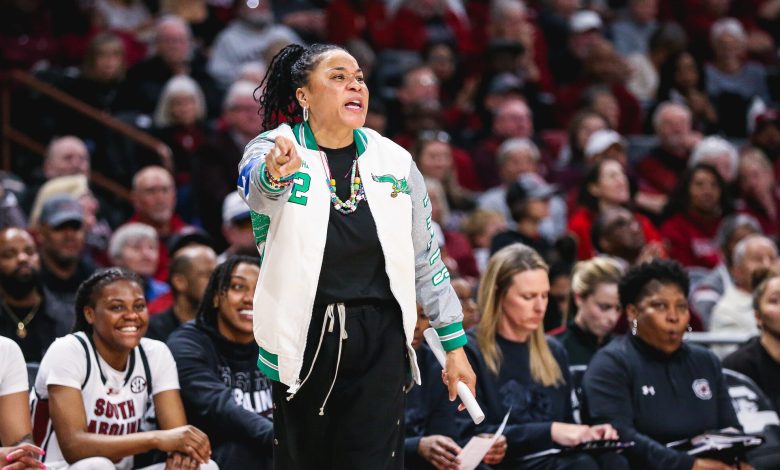‘South Carolina Fatigue’ in Women’s Basketball, According to Dawn Staley, Following Texas Premise

In the world of sports, success often breeds both admiration and resentment. Teams that dominate can experience what’s commonly referred to as “fatigue” from both opponents and fans, a phenomenon that’s particularly evident when a team continues to maintain its top-tier status year after year. For Dawn Staley and the South Carolina Gamecocks, their dominance in women’s college basketball has reached a level where it has led to what some have described as “South Carolina fatigue.” But what does this term mean, and why has Staley recently brought it up in light of the Texas Longhorns’ rise in women’s basketball?
As one of the most successful and talked-about teams in the nation, South Carolina has become synonymous with excellence in women’s college basketball. The Gamecocks have won multiple NCAA championships under Staley, with a roster full of talented players like Aliyah Boston and Zia Cooke, and the team has consistently been a powerhouse in the SEC and nationally. However, as is often the case with dominant teams, the higher they rise, the more scrutiny and challenges they face.
In a recent interview, Dawn Staley acknowledged that there is an increasing narrative of “South Carolina fatigue” emerging within the women’s basketball world, especially as programs like Texas gain more attention. The concept of “fatigue” doesn’t refer to physical exhaustion but to a growing sense of weariness or frustration, whether from fans tired of seeing the same team succeed or from other programs pushing back against a perceived imbalance in competition.
Let’s dive into the origins of this concept of “South Carolina fatigue,” explore Staley’s perspective on it, and understand why Texas’ recent rise has led to a unique confluence of sentiments in women’s basketball.
The Rise of South Carolina’s Dominance
Under the leadership of Dawn Staley, South Carolina has experienced an unprecedented level of success in women’s college basketball. Since taking over as head coach in 2008, Staley has built the program from one that was struggling to compete on the national stage into one of the most formidable forces in the game. Her coaching philosophy, which emphasizes defense, physicality, and mental toughness, has become the cornerstone of South Carolina’s success.
The program’s rise to national prominence was cemented when South Carolina won its first NCAA championship in 2017, a title that marked the program’s arrival among the elite. But Staley wasn’t done yet. She and her teams would go on to dominate the landscape, winning another national title in 2022, alongside consistently placing among the top-ranked teams in the nation. South Carolina’s success is not just measured by championships; it’s also about the way the team has consistently been at the forefront of women’s basketball.
Key players like Aliyah Boston, who was named the 2022 NCAA Player of the Year, and Bree Hall, who’s been integral in the team’s defensive schemes, have made South Carolina nearly unstoppable. Boston’s inside presence and leadership have been one of the primary reasons the Gamecocks have been so successful, while players like Zia Cooke bring scoring and energy to the offense. With Dawn Staley leading the charge, the Gamecocks have also been known for their suffocating defense, which has become one of the best in the country.
For the last few years, it has been clear: South Carolina is a national powerhouse, and any team that wants to challenge for a title must first go through the Gamecocks. But with that level of dominance comes a unique set of challenges.
The Emergence of ‘South Carolina Fatigue’
As South Carolina has continued its reign at the top of women’s college basketball, it’s understandable that some would begin to grow weary of the same team dominating every conversation and taking the spotlight year after year. The concept of “fatigue” has less to do with disliking the team’s players or coaches and more about the repetitiveness of their dominance. In every sport, when a single team or athlete consistently wins, it can lead to a sense of monotony. Fans of other programs yearn for a change, while media outlets search for fresh narratives and new storylines.
This fatigue, however, has taken on a particular shape in women’s basketball, where teams like UConn, Notre Dame, and Baylor were long seen as the sport’s elite programs. South Carolina’s emergence as a powerhouse was a shift in the balance of power within the NCAA women’s basketball landscape. The team’s sustained success, combined with its ability to remain at the top for years, has led to a fatigue in the public eye. While the Gamecocks remain widely respected, Staley has recognized that this feeling of “fatigue” is also being felt by some of the fanbases, as well as within other programs.
Dawn Staley’s Perspective on the Fatigue
In recent interviews, Staley has acknowledged the phenomenon of “South Carolina fatigue” and reflected on its implications. Rather than seeing it as a criticism, Staley has embraced it as part of the competitive nature of the sport. Her focus remains on her team, its performance, and the long-term legacy of the program, but she’s also recognized the importance of rivalry and competition in growing the sport. The fact that South Carolina has reached the level where “fatigue” is a topic of conversation is, in itself, a testament to the program’s success.
“It’s part of the process,” Staley said when asked about the “fatigue” narrative. “When you’re at the top, people are going to want to knock you off. They’ll get tired of you being in the conversation, and that’s just the nature of competition. It’s what drives the sport forward. If people are tired of hearing about South Carolina, that means we’re doing something right.”
Staley also pointed out that fatigue can be healthy for the growth of women’s basketball. When fans and media are “fatigued” by one team’s dominance, it often spurs a desire for change, which can lead to more competitive programs, more storylines, and ultimately, more excitement for the sport. “We can’t be complacent. We want everyone to get better. If they get tired of us, that means they’re pushing themselves to compete at the same level. And that’s what we want for the sport.”
For Staley, the fatigue is an indicator that the women’s game is maturing and that competition is becoming more diverse. The growth of rivalries and the emergence of new challengers like Texas, Stanford, and UConn provide compelling narratives that make the sport richer and more engaging.
The Role of Texas in the South Carolina Fatigue Narrative
In recent seasons, the rise of Texas as a national contender has added an interesting dynamic to the conversation about “South Carolina fatigue.” Under the leadership of head coach Vic Schaefer, the Longhorns have made tremendous strides, both in terms of recruiting and on-court performance. Texas has long been a solid program, but Schaefer’s arrival has elevated the team to a new level.
With star players like Rory Harmon and DeYona Gaston, Texas has positioned itself as one of the top challengers to South Carolina’s throne. The Longhorns’ aggressive defense, combined with their scoring ability, has made them a formidable opponent for the Gamecocks. As Texas has continued to rise, the narrative of “South Carolina fatigue” has been accompanied by a new subplot: the growing rivalry between the Gamecocks and the Longhorns.
Dawn Staley has expressed her excitement over Texas’ emergence, noting that a rivalry between South Carolina and Texas could be the future of women’s college basketball. “It’s a great thing for the sport,” Staley said, referring to Texas’ rise. “When you look at Texas, you see a program that’s hungry, that’s ready to compete at the highest level. They’re the type of program that pushes you to be better.”
The growing rivalry between South Carolina and Texas is helping to shift the focus away from just one dominant team in women’s basketball. With Texas challenging South Carolina for supremacy, it gives fans more to look forward to and creates a fresh storyline for the sport. Rather than focusing solely on “fatigue” from South Carolina’s dominance, the sport can now embrace multiple teams vying for the top spot.
A Changing Landscape in Women’s College Basketball
Dawn Staley’s perspective on “South Carolina fatigue” is also rooted in the understanding that the landscape of women’s college basketball is changing. While South Carolina has been the dominant force in the sport in recent years, other programs, including Texas, Stanford, Louisville, and UConn, are always working to close the gap. As more teams invest in resources, coaching, and recruiting, the level of competition will only increase, which can only be good for the sport.
In Staley’s eyes, this is an exciting time for women’s basketball. With more teams competing for national titles, with new rivalries forming, and with players pushing the limits of what’s possible on the court, the sport is in a period of rapid growth and evolution. The “fatigue” of one team’s dominance is, in a way, a reflection of the success and appeal of women’s basketball as a whole.
Conclusion
“South Carolina fatigue,” as acknowledged by Dawn Staley, is not just a narrative about her program’s dominance, but a natural byproduct of the growth of women’s college basketball. Staley recognizes that this fatigue is a sign of success—both for her team and for the sport. It shows that people
are invested in the game and are eager for new challengers and fresh competition. As Texas and other teams rise to prominence, the Gamecocks remain committed to improving and maintaining their excellence.
Ultimately, “South Carolina fatigue” isn’t about diminishing the Gamecocks’ accomplishments. Instead, it’s a reflection of the changing dynamics in women’s college basketball, where multiple programs now have the potential to vie for the top spot. And in that competitive environment, everyone—especially fans—benefits from the elevated level of play, the exciting rivalries, and the dynamic narratives that will shape the future of the sport.









